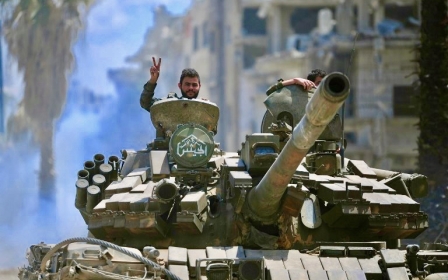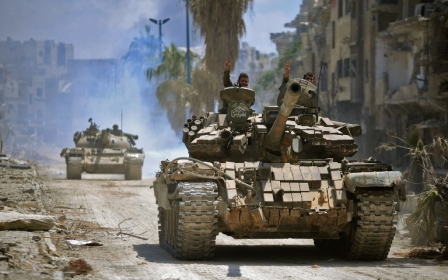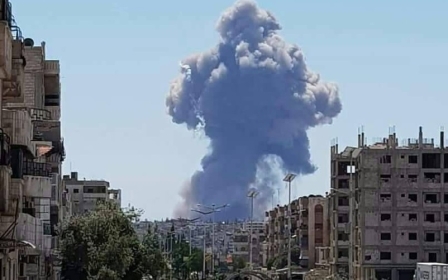Syrian army moves into Yarmouk after IS evacuation deal

The Syrian government has moved into the Yarmouk Palestinian refugee camp following the withdrawal of Islamic State fighters, according to the Syrian Observatory for Human Rights activist group.
With a blend of military pressure and negotiated withdrawals, Syrian President Bashar al-Assad has flushed rebels out of key territory around Damascus in recent months, leaving a last pocket of IS fighters in the capital's south.
His troops and allied Palestinian militiamen have fought since 19 April to recapture the area covering the Palestinian camp of Yarmouk and the adjacent districts of Qadam, Tadamun and Hajar al-Aswad.
A ceasefire at the weekend ushered in a brief wave of evacuations that wrapped up at around midday on Monday.
"The evacuations are over, after 32 buses took 1,600 people including IS fighters and their relatives out of southern Damascus on Sunday and Monday," said Observatory head Rami Abdel Rahman.
He said Syrian troops then entered IS-held parts of Yarmouk for combing operations.
Abdel Rahman said IS sleeper cells may remain in Yarmouk, however, and further military operations could lie ahead before the area is declared secure.
Under the deal, the first buses of IS fighters and civilians left southern Damascus early Sunday morning and a second batch evacuated the following night.
The Britain-based monitor said they headed towards Syria's badiyah, a vast stretch of desert in the country's centre and east where IS still controls some territory.
Once Yarmouk and adjacent areas are under its control, Syria's government will have fully secured Damascus and its outskirts from any military threat for the first time since 2012.
The government has not confirmed any deal with IS.
But in a first official comment on evacuations, a military source said Monday that a brief ceasefire had allowed some civilians to be transferred out overnight.
The source told state news agency SANA that women and children were bussed out, but pledged the government would resume its operations at noon (0900 GMT) on Monday.
AFP's correspondent in Damascus saw black smoke emerging from the capital's southern skyline around that time.
Secretive pullout
The latest evacuations, according to the Observatory, leave the government in control of Tadamun, Qadam and Hajar al-Aswad.
But the secretive nature of the withdrawals meant it was not immediately clear how many IS fighters or civilians - if any - remained in Yarmouk, Observatory chief Rami Abdel Rahman said.
The evacuations had been taking place with no media present, although photographs were shared of the events on social media.
"The Syrian government does not admit to negotiating with IS and wants to make sure the convoy is not targeted by the coalition led by Washington," he said.
Last year, IS fighters and relatives were evacuated from an area on the Lebanese-Syrian border under a deal between IS on one side, and Syria's government and its powerful Lebanese ally Hezbollah on the other.
The Damascus government was fiercely criticised over the agreement, which also enraged the US-led coalition carrying out air strikes against IS in Syria since 2014.
The coalition sent airplanes to shadow last year's convoy, conducting bombing raids to block it from reaching IS-held territory.
Yarmouk was the largest Palestinian camp in Syria and was put under crippling government siege in 2012 - making it one of the longest besiegements of Syria's war.
Attacks by Syria's government, as well as rebel and militant infighting, have ravaged the district for years.
The thriving 160,000-strong population has dwindled to just several hundred people.
Before launching its anti-IS push in Yarmouk, Syria's government managed to clear out other rebels from the area with military drives and evacuation deals.
More than 1,000 Islamist fighters and civilians left Qadam in March for opposition territory in northern Syria.
The following month, Assad's forces began the assault specifically targeting IS.
Those operations have killed more than 250 pro-government forces and 233 militants, as well as more than 60 civilians, according to the Observatory.
In other developments, large explosions were heard south of the capital overnight Sunday at an area said to hold a security facility used by Iran, Sky News' Arabic service reported.
The report follows a string of violent blasts at a Hama air base on Friday that the Observatory said killed at least 11 pro-Syrian government fighters. The origin of the blasts was not clear.
Israel has repeatedly targeted military sites that allegedly have an Iranian presence.
Middle East Eye propose une couverture et une analyse indépendantes et incomparables du Moyen-Orient, de l’Afrique du Nord et d’autres régions du monde. Pour en savoir plus sur la reprise de ce contenu et les frais qui s’appliquent, veuillez remplir ce formulaire [en anglais]. Pour en savoir plus sur MEE, cliquez ici [en anglais].




